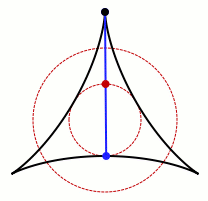Our website is made possible by displaying online advertisements to our visitors.
Please consider supporting us by disabling your ad blocker.
Kakeya set

In mathematics, a Kakeya set, or Besicovitch set, is a set of points in Euclidean space which contains a unit line segment in every direction. For instance, a disk of radius 1/2 in the Euclidean plane, or a ball of radius 1/2 in three-dimensional space, forms a Kakeya set. Much of the research in this area has studied the problem of how small such sets can be. Besicovitch showed that there are Besicovitch sets of measure zero.
A Kakeya needle set (sometimes also known as a Kakeya set) is a (Besicovitch) set in the plane with a stronger property, that a unit line segment can be rotated continuously through 180 degrees within it, returning to its original position with reversed orientation. Again, the disk of radius 1/2 is an example of a Kakeya needle set.
Previous Page Next Page


